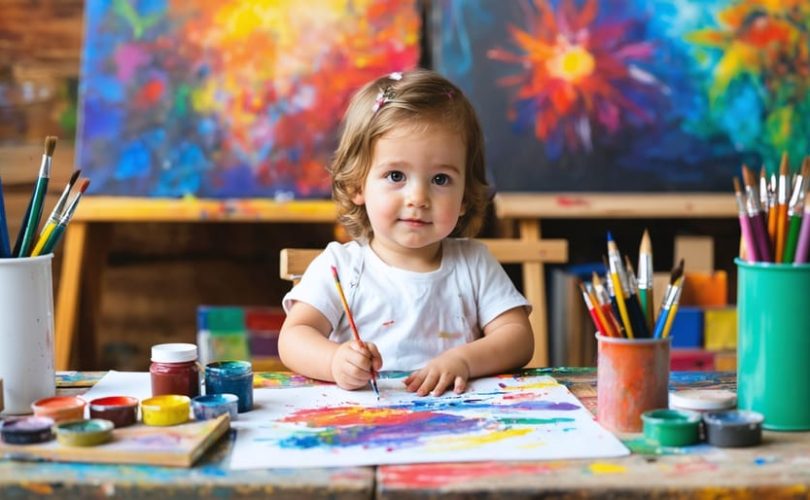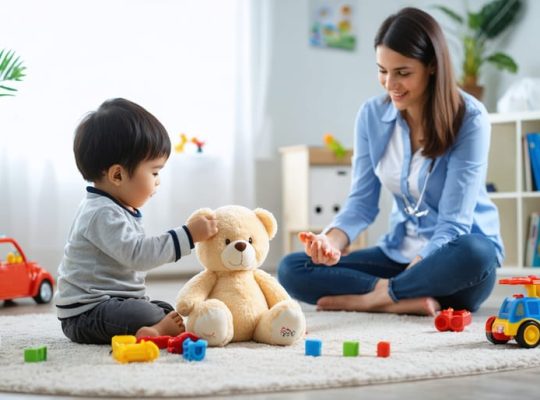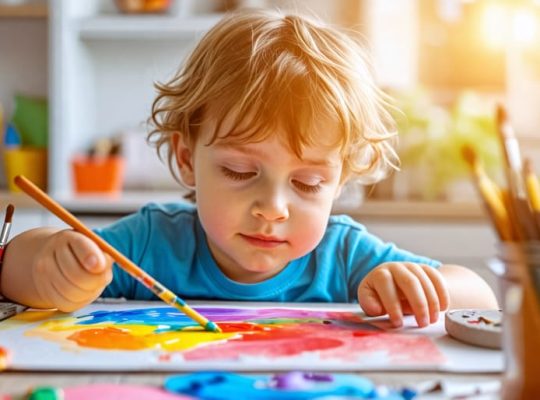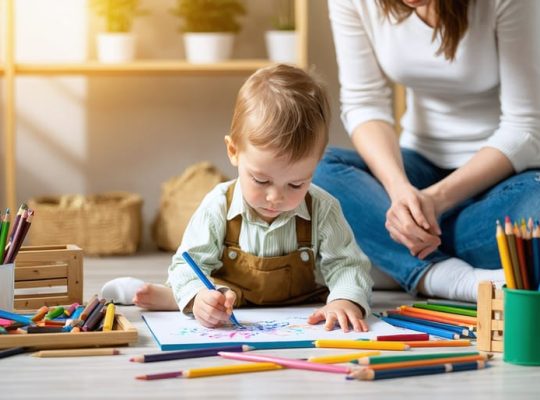Art stretches far beyond simple self-expression, unlocking powerful art therapy benefits that can transform your child’s emotional landscape. The seven fundamental themes of art—color, form, line, shape, space, texture, and value—serve as building blocks for creative development and emotional intelligence. These universal elements appear in children’s artwork across cultures and ages, offering a unique window into their inner world while fostering crucial developmental skills.
As parents and educators, understanding these themes helps us guide children’s artistic journey more effectively. Whether your child is finger-painting their first masterpiece or exploring complex mixed-media projects, these themes work together to create meaningful experiences that support emotional expression, problem-solving abilities, and cognitive development. Through conscious engagement with these artistic elements, children develop not just creative skills, but essential life tools for communication, self-awareness, and emotional regulation.
Join us as we explore how each theme contributes to your child’s growth, complete with practical activities you can implement today. These proven approaches combine artistic exploration with mental wellness, creating a foundation for lifelong creative expression and emotional resilience.
Color: The Language of Emotions
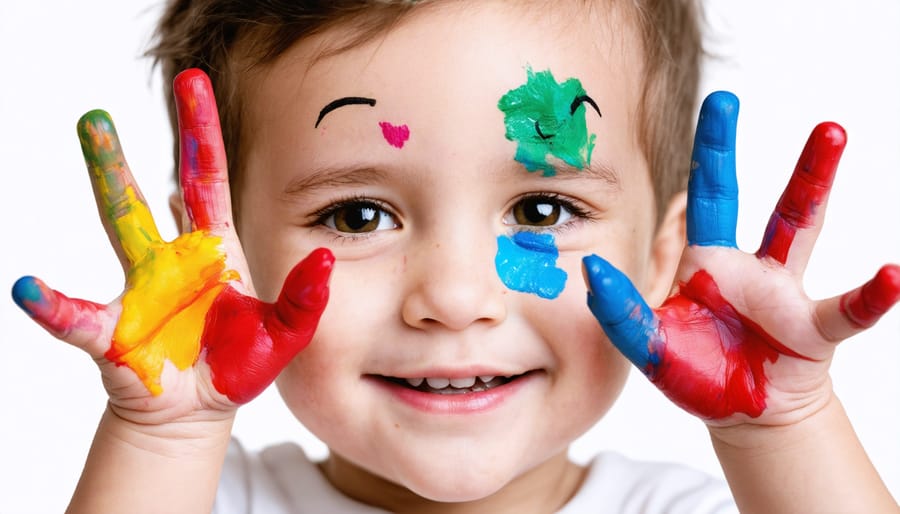
Reading Your Child’s Color Choices
Color choices in children’s artwork can offer valuable insights into their emotional state and inner world. When children express their emotions through art, their color preferences often reflect their feelings and experiences. Bright, warm colors like yellow and orange typically indicate happiness and enthusiasm, while cool blues and greens might suggest calmness or the need for peace. Pay attention to sudden changes in color preferences – a child who usually uses vibrant colors switching to darker shades might be processing difficult emotions.
However, avoid jumping to conclusions based on color choices alone. Instead, use them as conversation starters: “I notice you’re using lots of purple today – what made you choose that color?” This approach opens dialogue while respecting your child’s creative expression. Remember that cultural backgrounds and personal preferences also influence color choices, so always consider the bigger picture when interpreting your child’s artwork.
Color Activities for Emotional Expression
Colors are powerful tools for helping children express their emotions when words feel challenging. Try creating a “mood painting” activity where your child chooses colors that match their feelings – red for anger, blue for sadness, or yellow for happiness. Let them freely paint without judgment or rules.
Another engaging activity is the “emotion color wheel.” Help your child create their personal wheel by assigning colors to different emotions, then use it as a daily check-in tool. This helps them develop emotional awareness while having fun with art.
The “color breathing” exercise combines art and mindfulness. Have your child draw with their favorite color while taking deep breaths, releasing any difficult feelings onto paper. You can also try “color stories” where they create artwork using only colors that represent how their day went.
Remember, there’s no right or wrong way to use colors for emotional expression. The goal is to provide a safe, creative space for your child to explore and understand their feelings through art.
Form and Shape: Building Self-confidence
Supporting Growth Through Shape Exploration
Exploring shapes and forms through art provides children with a powerful outlet for emotional expression and developmental growth. When children engage with different shapes – whether drawing circles to express joy or sharp angles to show frustration – they’re developing crucial emotional vocabulary without the need for words. This natural connection between shapes and feelings helps children process complex emotions in a safe, creative way.
Try setting up a “shape station” where children can experiment with various geometric forms using different materials like clay, paper, or building blocks. Encourage them to create shapes that match their current mood or tell a story through shape combinations. This activity not only strengthens fine motor skills but also builds emotional awareness and self-expression capabilities.
Many art therapists note that children naturally gravitate toward certain shapes during different emotional states – curves often indicate comfort and security, while straight lines might represent structure and stability. By observing these preferences, parents and caregivers can better understand their child’s emotional state and provide appropriate support.
Line and Movement: Processing Anxiety
Calming Activities Through Line Work
Line work exercises offer a gentle way to help children process anxiety through artistic expression. Start with simple continuous line drawings, where your child draws without lifting their pencil from the paper. This rhythmic movement naturally calms the nervous system and promotes focus.
Encourage your child to create wave patterns, starting with gentle curves that flow across the page. As they become comfortable, introduce spiral drawings that start from the center and gradually expand outward. These circular motions can be especially soothing during moments of stress.
Another effective exercise is parallel line drawing, where children draw series of straight or curved lines next to each other. This repetitive action creates a meditative state while developing fine motor skills. For younger children, try “rainbow breathing” – drawing curved lines in different colors while taking deep breaths with each stroke.
Remember to emphasize that there’s no “right way” to create these patterns. The goal is to enjoy the process and find calm through movement.
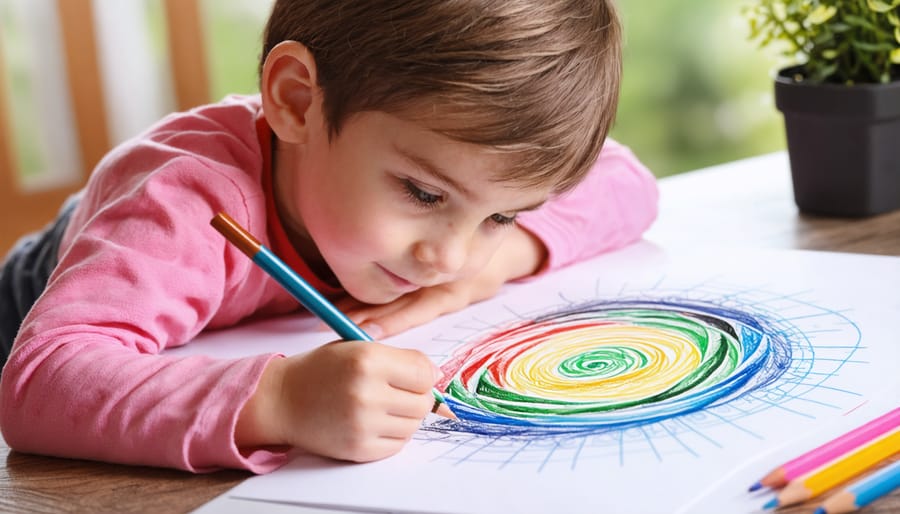
Space: Creating Safe Boundaries
When children create art, the way they use space often reveals their emotional needs for safety and security. Through their artwork, kids naturally establish boundaries, creating safe zones that reflect their desire for protection and personal space.
Watch how your child arranges elements on paper – some might cluster figures tightly in the center, showing a need for security, while others spread their artwork to the edges, suggesting confidence and exploration. A child who consistently draws boxes around figures or creates distinct separations between elements may be expressing their need for clear boundaries in their daily life.
Art therapist Sarah Martinez observes, “Children often use space instinctively to create ‘safety bubbles’ around the things that matter to them. It’s their way of processing and expressing their need for personal space and security.”
You can support this natural expression by providing various paper sizes and encouraging freedom in how they use the space. When a child draws a house with a fence or creates distinct areas in their artwork, they’re practicing important spatial awareness while also working through their emotional needs for structure and safety.
Try asking open-ended questions about their spatial choices: “Tell me about why you put this here?” or “What made you decide to draw these lines around your family?” These conversations can offer valuable insights into your child’s emotional world while validating their artistic choices.
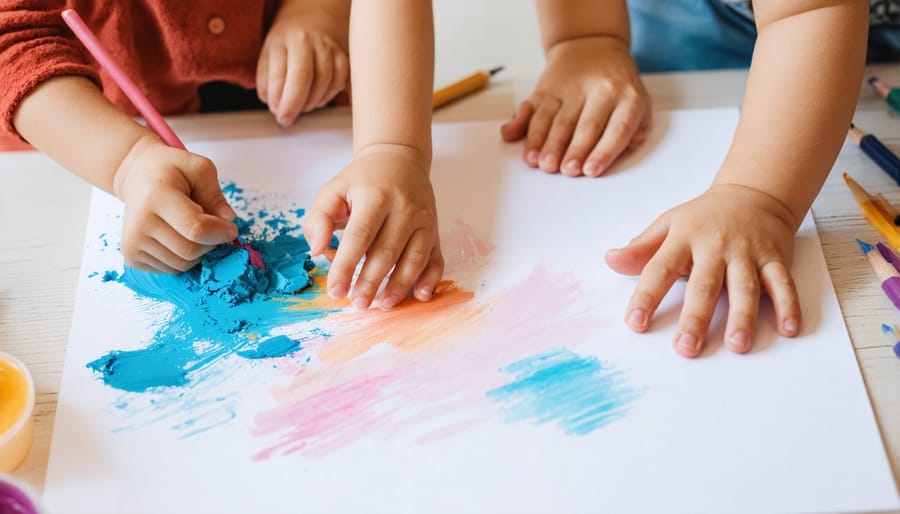
Texture: Sensory Processing and Emotional Regulation
Texture in art offers a unique gateway to emotional expression and sensory processing, particularly for children who may struggle to verbalize their feelings. When children engage with different textures – whether smooth, rough, bumpy, or soft – they’re not just creating art; they’re developing crucial sensory processing skills and emotional awareness.
Art therapist Maria Chen explains, “Running fingers through sand, squishing clay, or feeling the roughness of burlap helps children become more aware of their sensory responses and emotional states. This awareness is fundamental to emotional regulation.”
The therapeutic benefits of textural art are particularly evident in children with sensory processing challenges. Creating collages with various materials or working with textured paint can help desensitize children to challenging sensory experiences while providing a safe space for emotional expression.
Parents often report remarkable changes when incorporating textural art activities at home. Sarah, mother of a 7-year-old with anxiety, shares, “When my daughter feels overwhelmed, we break out the kinetic sand or textured papers. The simple act of touching different materials while creating helps her calm down and express what she’s feeling.”
To maximize the benefits of texture in art therapy, encourage exploration without judgment. Let children experiment with different materials and textures at their own pace, creating a supportive environment where sensory experiences become tools for emotional growth and self-expression.
Value: Building Emotional Depth
Value in art goes beyond simple light and dark contrasts – it’s a powerful tool for expressing and understanding emotions. When children explore different values in their artwork, they’re actually developing their emotional vocabulary and awareness. Just as we experience a range of feelings, from light and cheerful to dark and intense, value helps communicate these emotional depths.
Picture a child drawing a bright, sunny day versus a stormy afternoon. The lighter values might represent happiness and excitement, while darker shades could express uncertainty or contemplation. This exploration helps children recognize that all emotions are valid and natural parts of their experience.
Art therapist Sarah Martinez notes, “When children work with value, they’re learning to express complex feelings that they might not yet have words for. It’s like creating an emotional map through shadows and light.”
To explore value with your child, try simple activities like charcoal drawing or watercolor gradients. Ask them how different shades make them feel, and share your own observations. This creates a safe space for emotional expression and discussion. You might notice that your child naturally uses lighter values for happy scenes and darker ones for more serious subjects – this is their intuitive understanding of emotional expression through art.
Remember, there’s no “right” way to use value in art. Each child’s interpretation is unique and valuable, reflecting their personal emotional journey.
Art’s transformative power in child development cannot be overstated. Through these seven themes of art, children gain valuable tools for self-expression, emotional regulation, and cognitive development. When children engage in creative activities for emotional development, they build confidence, develop problem-solving skills, and learn to process complex emotions in healthy ways.
To get started on your artistic journey with your child, begin with simple activities that align with their interests. Set up a dedicated art space in your home, even if it’s just a small corner with basic supplies. Remember that the goal isn’t perfection – it’s about the process and the emotional connection you build together through creative expression.
Consider starting with one theme that resonates most with your child, whether it’s color exploration for emotional awareness or pattern-making for cognitive development. Gradually introduce new themes as your child grows more comfortable and confident in their artistic abilities.
Most importantly, maintain an open and supportive environment where your child feels safe to express themselves freely through art. Celebrate their creative efforts, ask questions about their work, and show genuine interest in their artistic journey. By incorporating these artistic themes into your child’s routine, you’re not just nurturing their creativity – you’re investing in their emotional wellbeing and mental health for years to come.

